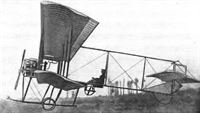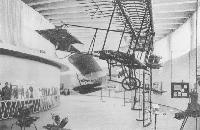
Описание
Страна: Италия
Год: 1911
J.Davilla Italian Aviation in the First World War. Vol.2: Aircraft A-H (A Centennial Perspective on Great War Airplanes 74)
Caproni Prewar Designs
Ca.3 - 1910 Biplane similar to Ca.1, but with a larger wing area to improve takeoff performance.
Ca.4 - 1910 Biplane with simple tail girder in order to simplify and lighten the construction; 25 hp engine.
Ca.5 - 1910 Biplane with central cockpit with engine driving a tractor propeller, with twin tail booms and a 50 hp Rebus engine.
Ca.6 - 1910 Biplane with single tail boom and open pilot, wings with double curvature, a monoplane tail and a 50 hp Rebus engine.
Ca.7 - 1910 Twin-engine biplane; it remained an unbuilt project.
- J.Davilla Italian Aviation in the First World War. Vol.2: Aircraft A-H (A Centennial Perspective on Great War Airplanes 74)
Фотографии
-
R.Abate, G.Alegi, G.Apostolo - Aeroplani Caproni: Gianni Caproni and His Aircraft, 1910-1983
The third biplane, constructed during the 1910-11 winter, was conceived with a lighter structure. A simple bamboo tailboom with three struts replaced the previous trussed fuselage. The wingspan was also greatly reduced, while the engine was carried over from the previous type.
-
R.Abate, G.Alegi, G.Apostolo - Aeroplani Caproni: Gianni Caproni and His Aircraft, 1910-1983
While starting the detailed design of his first monoplane, Caproni built other biplanes. The fifth biplane, which harked back to the third, stood out for its double curvature Coanda airfoil and metal tube tailboom longerons. It was tested by Caproni himself in association with the aviator Baragiola, who had built a hangar for his private Bleriot XI at Vizzola Ticino. The photo show the Ca.6, the sixth Caproni biplane, which also sported the characteristic double curvature airfoil and the lightened tailboom, constructed from hollowed-out wooden tubes. Still powered by the 50 hp Rebus, it was modified following some flights in spring 1911.
-
R.Abate, G.Alegi, G.Apostolo - Aeroplani Caproni: Gianni Caproni and His Aircraft, 1910-1983
The photo show the Ca.6, the sixth Caproni biplane, which also sported the characteristic double curvature airfoil and the lightened tailboom, constructed from hollowed-out wooden tubes. Still powered by the 50 hp Rebus, it was modified following some flights in spring 1911.
-
R.Abate, G.Alegi, G.Apostolo - Aeroplani Caproni: Gianni Caproni and His Aircraft, 1910-1983
The Esposizione dell’Aeronautica Italiana, held in Milan in June-October 1934, was the first major exhibition in Italy devoted to the history of flight. Designed by the best Italian architects and artists, coordinated by Giuseppe Pagano, and actively supported by industry, the show presented a coherent and convincing survey of the development of aviation. Gianni Caproni, who sat on the organizing committee, loaned three of the Caproni Museum’s aircraft, including the Ca.6 shown here.
-
R.Abate, G.Alegi, G.Apostolo - Aeroplani Caproni: Gianni Caproni and His Aircraft, 1910-1983
The Caproni Museum’s entrance in 1940. A visitor’s log sits on the round table. The Ca.1 and Ca.6, easily recognized by the variable pitch metal propeller, stand alongside the carpet. Directly behind the bronze bust are the Ca.36M’s empennages, partially hiding a Macchi-Nieuport 29 fuselage. By 1943 the decaying military situation forced the Museum to disperse its three main nuclei - Museum, library and archive -, blocking all activity but also preserving much of the material for posterity.
Другие самолёты на фотографии: Caproni Ca.1 - Ca.2 - Италия - 1910Caproni Ca.1 - Ca.3 (Ca.30 - Ca.36) - Италия - 1914







